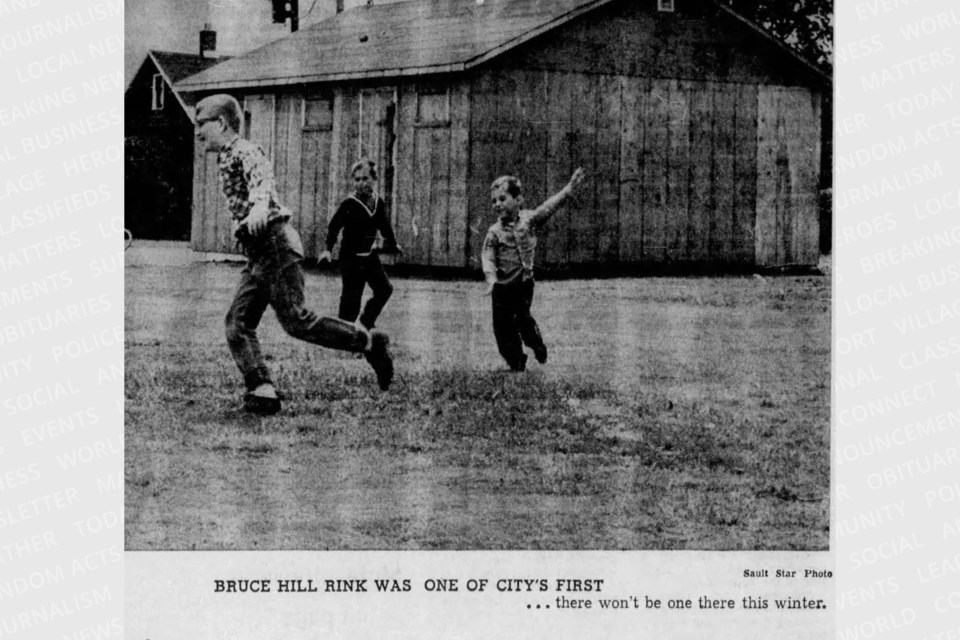From the archives of the Sault Ste. Marie Public Library:
In the early 1930s, as shots were fired overseas, rink boards were assembled for the youth of Sault Ste. Marie. It was the vision of William J. (“Bill”) Edwards that every neighbourhood in the city would have a place to skate during the long winter months. He was clear that they should be referred to as just that – ‘the neighbourhood rinks’– since they were for the children and teens, first and foremost.
Of course, the Sault was already well-acquainted with outdoor shinny. Family-run backyard rinks and good old-fashioned lakes and ponds were a northern lifestyle. In fact, preventing falls through the St. Marys River’s thinning ice was one of the pitches Edwards brought forward to the city with his proposal. But he insisted that a network of outdoor rinks through each city section would be beneficial for other important reasons, too.
Edwards was passionate about advancing the quality of athletics from the time he arrived as assistant traffic manager for Algoma Central Railway in 1918. After executive work with the Great War Veterans baseball club and with the original Greyhounds Hockey Club Allan Cup champions, he eventually began devoting more energy to younger players.
His 1921 proposal for a midget hockey league received city-wide support and propelled many children into the sport. There were only so many spaces for the youngest of skaters to use though, and not every family could pay for the few privatized rinks. It was in 1934 that Bill Edwards resigned as president of the city leagues and began forging his path to become ‘the moving spirit’ of the Sault’s neighbourhood rinks.
Bruce Hill and Central Park – now known as Esposito Park – were among the first and most populated of the neighbourhood rinks, along with the Bayview area (Goulais Ave), the Harris and Buckley area (on the old David Kyle School grounds/Douglas St), the East End area behind the old Alex Muir school (Kohler St, but in the first year the rink was on MacGregor Ave), Gladstone Ave, and neighbouring the Bruce Street fire hall. Street names like Simpson, Wallace Terrace, Brock, and St. Veronica would also be added to the list.
Thousands of skates, both black and white, laced up over the years thanks to a conglomerate of support from the city; clubs like Rotary, Lions, Kiwanis and the YMCA; and a few churches. It cost approximately $150 to set up and $85 to maintain each rink throughout the 1938 season, which included caretaker costs. Edwards always asserted that the benefits of ‘keeping youngsters out of mischief’ far exceeded any costs incurred.
While Edwards supervised the rinks in the beginning years, the children were expected to help rink caretakers by cleaning the ice and removing the snow after snowstorms. In exchange, they had a haven to return to each day, with a curfew of 9 p.m. for the younger ones and 10 p.m. for the older. Morning hockey practice, afternoon skating parties, and evening fundraisers were common weekend occurrences, and citizens would look to the local Sault Star columns to list exactly who was in attendance or which neighbourhood was challenging another to a game and when.
Even the caretakers found competitive fun in seeing who could maintain the most favorable ice conditions. Bruce Hill’s Mr. William ‘Bill’ Luxton seems to have gone down in written history as among the best, after a previous ice-making career at the curling rink. “They had tricks they don’t bother with now. They made special scrapers and spread snow on the edge of the ice when there was no skating, so that sun reflecting from the boards wouldn’t melt the ice when the weather became warmer,” said Mr. Murphy to the Sault Star on July 5, 1967.
By 1940, with Edwards’ support, Edison Danby took over as rink supervisor but his efforts with Sault sport were not over yet. He continued supporting the neighbourhood rink initiative while touting the need for a larger indoor community building. The building, which would include an artificial ice rink, came to fruition in 1946-1949 as a post-war project to be named the Memorial Gardens. It was the final project Edwards left his mark on in Sault Ste. Marie.
Edwards departed for new horizons in 1946, just short of the Gardens’ official opening. President of the Civic Club, VP and executive member of the Board of Trade, school trustee, and sports director were some of the official titles he left behind after a successful 28-year Sault tenure. His legacy remains as a charter member in the Memorial Gardens Hockey Hall of Fame, a ceremony which he returned to attend in 1963, as well as in the quality and culture of Sault hockey that continues to radiate today.
Each week, the Sault Ste. Marie Public Library and its Archives provide SooToday readers with a glimpse of the city’s past.
Find out more of what the Public Library has to offer at www.ssmpl.ca and look for more "Remember This?" columns here.
